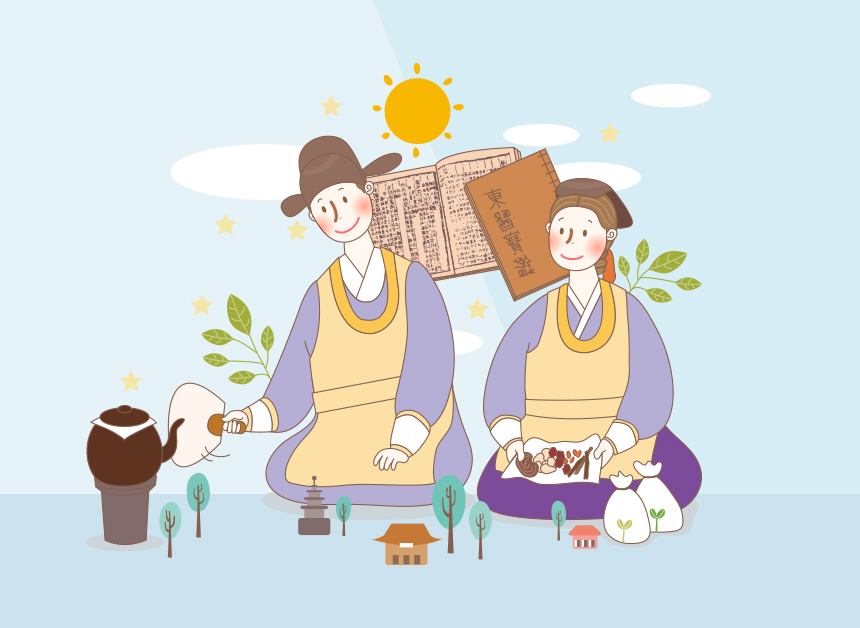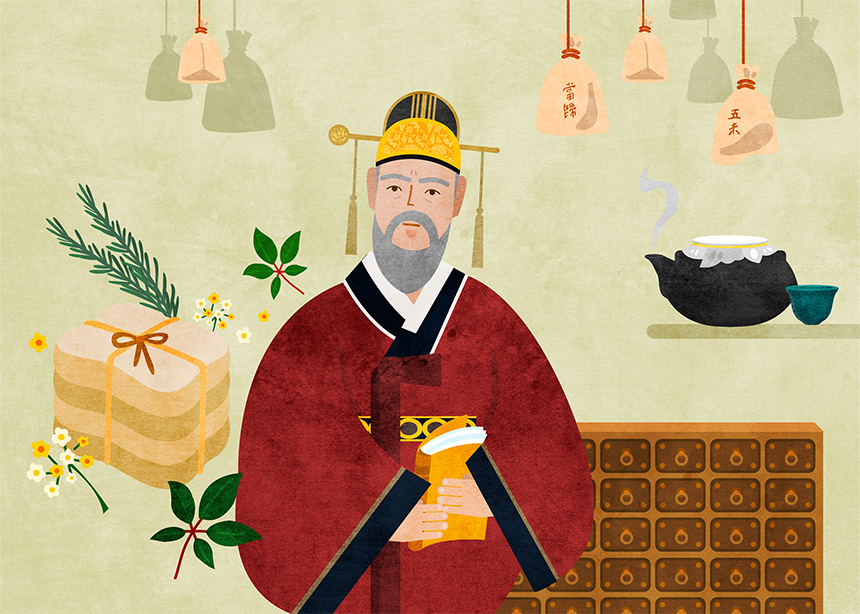Korean Medicine
Birth of Donguibogam
The First Stage (1596-1597): The period where the project of DongUiBoGam is launched and its outline drafted. The benevolent King Seonjo took interest in medicine as a mean to salvage his subjects from pain and suffering. So he summoned Heo Jun in the Byungshin Year (丙申年, 1596 A.D.), who was a Taeui (태의/太醫), a royal physician at the time, and ordered the following: "From my observations, all the medical texts that currently exist are trifling collections of adaptations copied from the Chinese medicas; Therefore, there is a need to compile all the medical texts to produce a single encyclopedia And since the illnesses of men stem from negligence of health, it should put practices of good health before covering the topics of medications or acupuncture; Because all the medicas are exhaustive, take care in deducing their key points; The reason why many meet a premature death in remote and secluded regions with a shortage of physicians and medicine is because though our nation produces an abundance of medicinal ingredients, they are not known to many; Therefore, categorize and list the nomenclatures of those medicinal ingredients so that the people may access its knowledge easily. " Upon hearing the King's words, Heo Jun set up an organization to start its draft with Yuui(유의/儒醫) Jeong Jak, and Taeui (태의/太醫) Yang Ye-su, Kim Eung-tak, Lee Myeong-won, Jeong Ye-nam, and more. However, when its outline was almost set, the work came to a hiatus due to the uprising of Jeongyu Jaeran (정유재란/丁酉再亂), the second Japanese invasion in the year 1597, which saw the dispersion of the physicians in all directions.

The second publication stage of DongUiBoGam
The Second Stage(1597-1608): After the Jeongyu Jaeran (정유재란/丁酉再亂), or the second Japanese invasion, the publication of DongUiBoGam was left entirely to the hands of Heo Jun. However, before he could even finish drafting half of the text, the event of King Seonjo’s death results in his banishment. Afterwards, the late King gave orders for Heo Jun to continue in his work alone, and provided him with over 500 medical texts stored at the court to aid his research. But before he could even reach halfway into his work, the new King too, passed away.
The third publication stage of DongUiBoGam
The Third Stage(1608~1610): The completion stage during his exile which lasted two and a half years. In the Gyeonsul Year (경술년, 庚戌年, 1610 A.D.), the third year of King Gwanghaegun's ascension to the throne, Heo Jun finally completed his work and presented it before the king, which totaled 25 volumes under the title DongUiBoGam. King Gwanghaegun, pleased with the report of its completion, expressed his content with the following: "Heo Jun of Yangpyeong-gun respected the orders of the late King Seonjo to compile a medical encyclopedia, and continued his work despite the times of refuge and exile, to now present its completed text before me. I cannot hold back my regrets that this text, ordered by our previous King, has only seen its completion after his passing away and my ascension."
The fourth publication stage of DongUiBoGam
The Fourth Stage(1610~1613): The printing and publication period
The presswork venue was changed from Naeuiwon (내의원/內醫院) to Hasam-do, the three provinces of Chungcheong-do, Jeolla-do, and Gyeongsang-do due to financial burdens, then re-shifted to Naeuiwon where it was finally published for distribution.
Heo Jun
Joseon’s grand physician who set the foundations of traditional Korean medicine

Heojun(許浚 : 1539~1615)
Heo Jun is Joseon's grand physician who set the foundations for traditional Korean medicine with his systematic compilation of its subjectsin his greatest work, Dongui Bogam (동의보감/東醫寶鑑). Heo Jun's (1539~1615) courtesy name (字) is Cheong-won (청원/淸源) and his pen name (雅號) is Guam (구암/龜岩). He is the 20th generation descendant of Heo Seon-mun (허선문/許宣文), the progenitor of the Yangcheon Heo clan who also became the commune leader of Gongam during the reign of King Taejo in the Goryeo dynasty. Though born an illegitimate, he chose to walk the path of medicine and was soon called in to the royal court for medical service in his early 30's. By the time was 36, his talents were widely recognized for him to step up to the responsibility of examining and diagnosing the King's conditions. When the Imjin Waeran War (임진왜란/壬辰倭亂) broke out, he escorted and looked after King Seonjo until the very end of the King's refuge in Uiju with his responsibilities as a royal physician. At that time, many of the courtiers abandoned their King and took flight to retain their lives, with only a minute few remainingby King Seonjo to escort him to the very end of his refuge. Heo Jun devoted himself in practicing medicine, and left behind him many accomplishments and writings. In particular is his greatest achievement, Dongui Bogam (동의보감/東醫寶鑑), which he published during his time in exile. Completed in 1610 when he was aged 71, it has left a significant legacy in world medicine.




